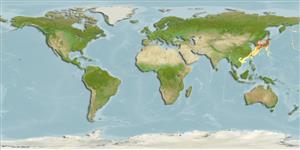Holocephali (chimeren) (chimaeras) >
Chimaeriformes (Chimaeras) >
Chimaeridae (Shortnose chimaeras or ratfishes)
Etymology: Hydrolagus: hydro-, combining form of hydor (Gr.), water; lagos (Gr.), hare, i.e., “water rabbit,” probably referring to three pairs of tooth plates, which tend to protrude from the mouth like a rabbit’s incisors (See ETYFish); barbouri: In honor of American herpetologist Thomas Barbour (1884‒1946), later director of the Harvard Museum of Comparative Zoology, “through whose enthusiastic interest the opportunity of description was provided” (See ETYFish).
Eponymy: Dr Thomas Barbour (1884–1946) was an American zoologist. [...] (Ref. 128868), visit book page.
More on author: Garman.
Environment: milieu / climate zone / depth range / distribution range
Ecologie
marien bathydemersaal; diepte 100 - 1100 m (Ref. 58497). Temperate
Northwest Pacific: Sea of Japan and East China Sea.
Grootte / Gewicht / Leeftijd
Maturity: Lm ? range ? - ? cm
Common length : 60.0 cm TL mannelijk / geslacht onbekend; (Ref. 3197)
Korte beschrijving
Determinatiesleutels | Morfologie | Morfometrie
Dark chocolate-brown with large light colored spots.
Carnivorous. Oviparous (Ref. 205). Eggs are encased in horny shells (Ref. 205).
Levenscyclus en paargedrag
Maturiteit | Voortplanting | Paaien | Eieren | Fecunditeit | Larven
Masuda, H. and G.R. Allen, 1993. Meeresfische der Welt - Groß-Indopazifische Region. Tetra Verlag, Herrenteich, Melle. 528 p. (Ref. 9137)
Status op de Rode Lijst van het IUCN (Ref. 130435: Version 2024-2)
Gevaar voor de mens
Harmless
Gebruik door de mens
Visserij: commercieel
Tools
Speciale rapporten
Download XML
Internetbronnen
Estimates based on models
Preferred temperature (Ref.
123201): 0.5 - 4, mean 1.6 °C (based on 49 cells).
Fylogenetische diversiteitsindex (Ref.
82804): PD
50 = 0.5000 [Uniqueness, from 0.5 = low to 2.0 = high].
Bayesian length-weight: a=0.00331 (0.00137 - 0.00798), b=3.07 (2.86 - 3.28), in cm total length, based on LWR estimates for this (Sub)family-body shape (Ref.
93245).
Trofisch niveau (Ref.
69278): 3.5 ±0.37 se; based on food items.
Weerstandsvermogen (Ref.
120179): laag, minimale populatieverdubbelingstijd 4,5-14 jaar (Assuming Fec <100).
Fishing Vulnerability (Ref.
59153): Moderate to high vulnerability (54 of 100).
